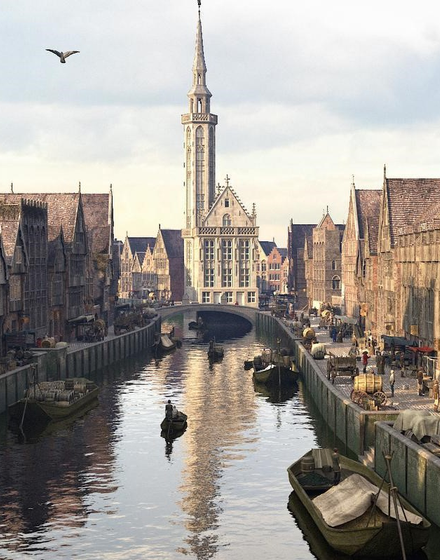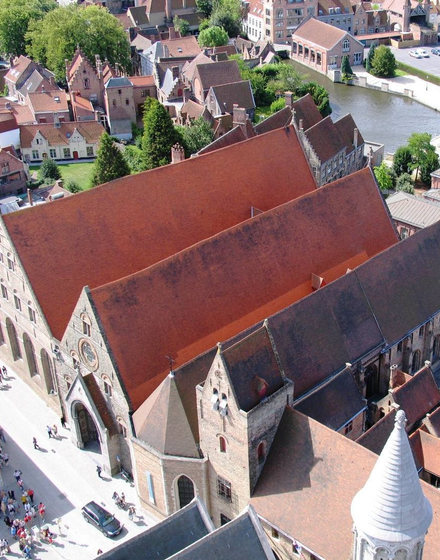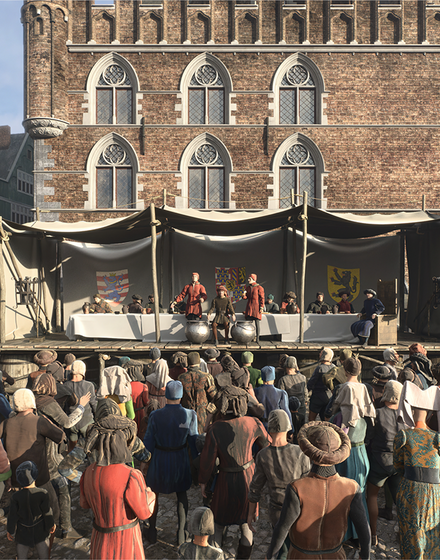This website uses cookies to store your preferences in order to facilitate navigation.
HISTORICAL WALK WITH VIRTUAL REALITY
FREE

 To
ToThis fascinating walk guides you through the Bruges of past and present. Some locations literally take you on a journey through time with the help of Virtual Reality viewers.

1. Start: Van Eyckplein
We are now on the Van Eyckplein (no. 2), where the Sint-Jansbrug used to be. Both the name Jan Van Eyck and the location are very significant for 15th-century Bruges. The most famous of the Flemish Primitives had his studio in the Gouden-Handstraat. Van Eyck Square and the surrounding area formed the international trade district of Bruges in the late Middle Ages. Transport was an important part of this trade and the wine schroders were partly responsible for this. In 1441, the income of the wine schroders was the first and best prize in the lottery. Right in front of us is the impressive gatehouse. This monument was built in the early 15th century and served as a meeting and gathering place for Bruges' elite and the White Bear Society. This company organized an annual tournament on Bruges Market Square.
TIP: Look through the VR viewer on the square to make medieval Bruges come alive again. This is also the start of a cycle route that takes you along the Lost Ports of the Zwin, the medieval port infrastructure of Bruges.
2. Woensdagmarkt - Oosterlingenplein
The Wednesday Market was constructed in 1458, along with a new consulate for the German Hanseatic League. The relationship between Bruges and the German Hanseatic League dates back to around 1250. The Hanseatic League was a partnership of traders and towns that ran from Bruges to Scandinavia. In Bruges, they were better known as Orientals, after the wind direction from which they came. It was not until 1457- 58 that the Hanseatic League got their own nation house. After the Hanseatic League left Bruges in 1553, the square was named the Wednesday Market, after the weekly market on the square. There is a statue of Hans Memlinc here, who was one of the most famous Flemish Primitives.
To the right of Oosterlingen Square are the remains of Oosterlingen House. This monumental complex was erected between 1478 and 1491 and was a highlight of Bruges architecture. This monument fell into disrepair and in front of you today is just a remnant of the imposing complex.
3. Korte Winkel
This and surrounding streets were home to the former Spanish trading quarter. The streets were dominated by the large houses and warehouses of the Spanish wool traders in the 15th and 16th centuries. The end of the street features one of the two remaining preserved wooden facades in Bruges (No. 3). Most of the houses had wooden facades until the 16th century.
 Metropolitan Museum of Art, New York.jpg)
4. Hof Bladelin
This city palace was founded by Pieter Bladelin, a top official under Duke Philip the Good. He sold the property to the Medici family around 1470, and they set up a bank branch there. Tommaso Portinari assumed the day-to-day management of the Medici bank between 1465 and 1480. Representatives of the Medicis were prohibited from gambling, yet Portinari was one of the winners of the 1465 lottery. This suggests that even then lotteries were viewed differently from gambling.
TIP: Enter the courtyard. The oldest Renaissance statues in Bruges (a portrait of Lorenzo de Medici and his wife) are on display.
 Timescope, UGent, Nationale Loterij (1).png)
5. Beursplein
Here, at the junction of the current Academiestraat and Vlamingstraat, was the Beursplein. This was undoubtedly the most important meeting place for international trade. The name Ter Beurze came from the Van der Beurze family, who ran an inn there. In addition to several drinking establishments, the nation houses of the Genoese, Venetians and Florentines were located here. This bustling square was the nucleus of the Bruges money exchange market and the name of the van der Beurze family continued to live on in today's globally known and used term stock exchange (beurs).
6. Stadsschouwburg and Kraanplein
In 1869, a brand new municipal theater was built here (No. 6). In 1934, the first Belgian state lottery was established, and shortly after - in 1936 - a draw of the Colonial Lottery, precursor of the National Lottery, was held in the City Theatre of Bruges. An important feature of lotteries, both in the Middle Ages and today, is that they are held in public.
TIP: Attend a live lottery draw in Brussels, at Place de Brouckère.
On the opposite side of the City Theatre is the Crane Square. This is where the Bruges city crane was located. This wooden structure was used to load and unload wine barrels controlled by the schroders. This whole economic event was the basis for the first lottery prize in 1441 in Bruges.
TIP: A replica of the crane can be seen in Sas Square.
 Stadsarchief Brugge.jpg)
7. Markt
Bruges Market Square formed the core of the first lotteries. For the draw, a stage was built on which the aldermen and the city magistrates were present. Each was assigned a job. Some wrote down the winners, others attached the lottery tickets to a string so that order was maintained. There were also, in many cases, a tractor and two readers. To spice things up, music was played and poets were hired.
TIP: Climb Bruges' belfry.
8. Onze-Lieve-Vrouwekerk
At 115.5 metres, the tower of this imposing Gothic church is the second highest brick church tower in the world! In 1555, the church council organized a lottery to benefit the church.
TIP: Visit the church and admire the tombs of Charles the Bold and Mary of Burgundy and a real Michelangelo.

9. Sint-Janshospitaal
The hospital has been here since the mid-12th century and is the oldest healthcare institution in Europe. Hospitals and madhouses (institutions for the mentally ill) also regularly benefitted from a lottery. During the 19th century, several local lotteries were organized to support the poor and sick.
TIP: St. John's Hospital, now a museum, is worth a visit if you want to come face to face with the work of Hans Memling, one of the masters of the Flemish Primitives. The medieval architecture and the extensive collection are also worth the visit.
 Brugse Musea, artinflanders.be.png)
10. Bogardenschool
The Bogarden School was established to teach the poor and orphans a craft and provide shelter, to offer hope of a better position in society later on. In 1574, the Bogarden School organised a lottery to sanitise the water supply. Pieter Pourbus created a beautiful poster to advertise this lottery.
DID YOU KNOW: The National Lottery joins this long tradition of child poverty, supporting for example the Bruges foundation Pelicano.
11. Tuin Arendshof
This city garden is home to the only remnant of the Waterhalle that used to stand on the Market Place. This monument was built at the end of the 13th century and was a gigantic covered port. During the construction of the Provincial Court, on the site where the Waterhalle used to be, these two columns were excavated and moved to the garden. The grooves in the columns are traces of the mooring ropes that chafed along these behemoths for years.
TIP: The garden is located between two important Bruges Museums. Across the water, you can visit the 15th-century city palace of Lodewijk van Gruuthuse. On the other side is the Groeninge Museum with an important art collection.
12. Blinde Ezelstraat
The Blinde Ezelstraat was the location of a pub called the Blende Ezel (Blind Donkey) in the 1440-1450s. They supplied the wine for the lottery of 1446, in which, among others, Jan van Eyck’s widow participated. After all, a draw was a spectacular party and a party needs wine. Walking down the street to end up back at De Burg.
TIP: The Groeninge Museum features the portrait of Margareta van Eyck and The Madonna with Canon Joris van der Paele by Jan van Eyck.

13. Burg
The Count of Flanders’ castle was situated on this square, which then grew into the administrative and religious centre of the city. The south side features an impressive row of monuments. First up, on the left, are the Brugse Vrije (Liberty of Bruges) buildings, nowadays home to the city archives. It is also where the city ledger of 1441 is kept, which contains the oldest mention of a lottery in our regions. In addition to a municipal appointment, various cash prizes were raffled for the first time.
Next to the city archives is the impressive late-Gothic city hall, which is one of the oldest in the Low Countries. Construction began in 1376. Next to it, on the ground floor, is the Romanesque St. Basil’s Chapel, with the Basilica of the Holy Blood on the second floor. Every year, this relic is carried around on Ascension Day as part of the Procession of the Holy Blood. This procession dates back to the 14th century and acquired the status of UNESCO Intangible Cultural Heritage. The National Lottery is an important partner of the procession.
14. College of Europe
The College of Europe in Bruges was founded in 1949 after the European Conference in The Hague. Together with the establishment in Warsaw, the school aims to train university students in European studies. The National Lottery was one of the partners in the restoration of the complex on the Verversdijk, the former Jesuit College. Today, the National Lottery supports two scholarship students every year.
15. Sint-Annakerk
On the other side of St. Anne's Bridge, it’s a straight road to St. Anne's Church (No. 15). St. Anne's Parish was founded in 1496 as a split from the outer parish of St. Cross. The construction of the church was difficult, and in 1554 the church masters received permission from Charles V to set up a lottery to finally finish the church.
TIP: Visit the Adornes domain, you can't miss the impressive chapel on your way!
16. Sint-Jorisgilde
The St. George's Guild is the Oldest Crossbowmen's Guild in the country, with a first mention in 1321, and also one of the first to organise a lottery in 1457 and 1486.
 Sint-Sebastiaansgilde Brugge.png)
17. End: Sint-Sebastiaansgilde
The Saint Sebastian's Guild is unique in Bruges association life. It has been in existence since the 14th century. As a result, it has a very rich archive, which starts in 1379 and continues to the present day. This archive boasts accounts and posters that prove the guild organised a lottery as early as 1560. The lottery in 1753 took place in the King's Hall of the Guild and was immortalised in a painting that can still be admired at the Guild. The National Lottery supports this unique heritage site and is providing, among other things, financial support for the restoration of the painting.
TIP: A visit to the Guild is possible by appointment.
Authors: Lennert Lapeere, Thais Aerts, Frank Demeyere, Veerle Geurs
Copyright images: Timescope, Universiteit Gent; Stadsarchief Brugge; Metropolitan Museum of Art, New York; Nationale Loterij; Bayerische Staatsbibliothek; Phoebus Foundation; Brugse Musea; Universiteitsbibliotheek Gent; Koninklijke Bibliotheek van België (KBR); Onroerend erfgoed Vlaanderen, Debonne Vincent